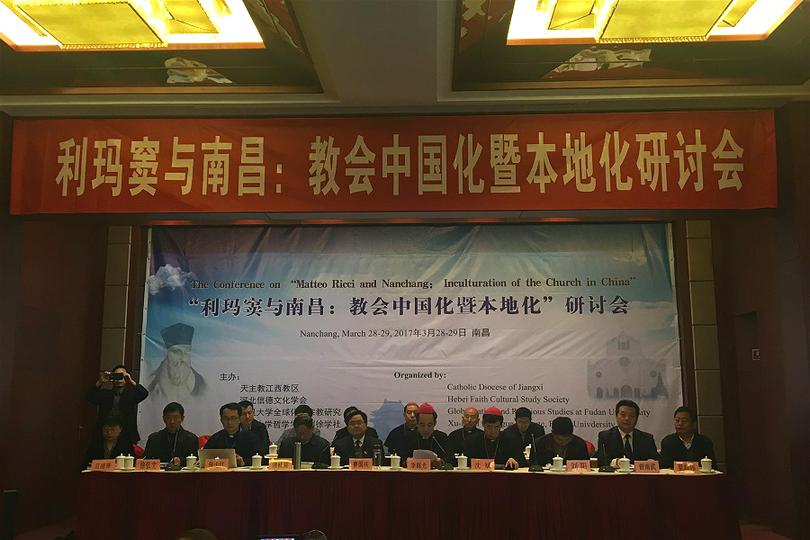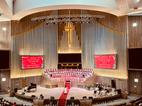A pioneer of Catholicism in China, Matteo Ricci was also a scholar who bridged western and eastern classics. He learned Chinese, wore Confucian clothes, utilized technology, associated with bigwigs, and studied Confucianism. He was the founder of Christianity’s spread in China via a nonreligious approach. His association with bigwigs made him not only a preacher but also one who advanced civilization.
The practices and achievements of Matteo Ricci have lightened the process of Christian localization in China. Zhoukou city in Henan province is a good example.
In the seminar "Matteo Ricci and Nanchang: Inculturation of Christianity in China," Rev. Ma Xin, chairman of Zhoukou CCC&TSPM, gave a speech on the practices and achievement of inculturation of Christianity in Zhoukou. He mentioned that the Church of Zhoukou not only adhered to the spirit of spreading the Gospel but also carried on some useful trials in social service, among which there was a reflection on Matteo Ricci’s practices in China.
The Church in Zhoukou has made obvious achievements in recent years both in constructing its theological system and in church development model. It was commended by the scholars for paving a new path in social service and church development.
To sum up the experiences and share the theological system and the practical wisdom, Rev. Ma analyzed the prime motivator of the church achievements.
1. Harmonious Church-State relations
As a foreigner in China, Matteo Ricci acted as a peacemaker between Catholicism and the ruling class. Understanding this, the Church in Zhoukou has established a sense of localization or inculturation. Thinking that a church could not develop without region and culture, it could be only be accepted by local people with a cultural identity.
With the awareness of cultural identity, the Church of Zhoukou has built a good church-state relationship with the local government. They have carried out many social activities with the support of the local government.
2. Theology of “River” Culture
Matteo Ricci combined western and eastern culture, adapting himself to the eastern way in language, clothing and other aspects as an expression of his agreement with Chinese culture. He explored the similarities between Christian theology and Chinese culture, combining them and showing the spirit of incarnation.
Learning from Matteo Ricci, Rev. Ma realized that since the church appearance was shaped by theology and local culture, the only way a church could be accepted in the region was to combine the core of the gospel with local culture so that the expression could be widely acknowledged.
To achieve a combined and acknowledged expression of Christianity, the Church of Zhoukou has come up with the goal of building a theology of “river” culture. This theology blends Christianity with Chinese traditional culture, working like the confluence of two rivers. When two rivers meet each other, they do not come into collision with each other but meet each other in peace and quiet. Like this, the church hopes that Christian culture could be an organic part of Chinese culture, forming a self-contained Chinese theology.
3 “Three-Chapel” “Three-People” Church model
Being of rich knowledge and experience, Matteo Ricci was also easy-going and approachable. He made a good model for the church in inculturation.
With this model in mind, Rev. Ma believes that the church could serve as a medium in building a harmonious society. To come into play, the church should integrate into society. Social Service and Community Care are good approaches to achieve the social values of the church.
The Church of Zhoukou wants to a three-facet church: a chapel for believers to worship God, an auditorium for believers to learn laws and regulations as well as cultural knowledge, and a classroom for believers to learn useful techniques to earn money. Not only that, the preachers there are three-role preachers: they preach the Gospel to the unreached, serve local believers, and work for local farmers to get rich.
The three-facet chapel and three-role preacher re-defined Christianity in Zhoukou, providing a fusion platform for Christianity and traditional Chinese culture and developing the social values of the church and preachers.
Based on the ideas of three-in-one, the Church of Zhoukou has established a Service Center for “farmer, countryside and agriculture.” They offer the latest techniques by inviting experts in cultivation and plantation. With the help of training, most of the church volunteers became experienced in leading local residents out of poverty. This happens to have the same view of the preaching tactics of Matteo Ricci.
-Translated By Alice










